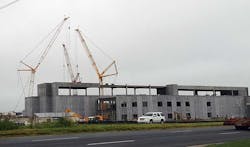Why You Should Question Everything to Truly Drive Data Center Innovation
In this edition of Voices of the Industry, Zech Connell, Data Center Market Manager at ProLift Rigging explores how questioning everything about the construction process can drive data center innovation.
Zech Connell, Data Center Market Manager at ProLift Rigging
According to Dr. Ken Hudson, the definition of innovation is the creation, development and implementation of a new product, process, or service, with the aim of improving efficiency, effectiveness, or competitive advantage. We can all agree that we want to be more efficient, effective, and certainly have a competitive advantage, especially with the ever-looming challenge of speed to market and rise of healthy competition on all fronts.
Chris Crosby, CEO at Compass Datacenters, recently said on the Data Center Frontier podcast with Rich Miller “If you’re not innovating, you’re dying.” This is a strong stance advocating for innovation from one of the leaders in the industry and we believe he is right. Crosby goes on to mention their initiative of project buffering in partnership with ProLift. This direct partnership allows ProLift to handle all upfront logistics, transportation, and storage of Compass OFCI equipment, removing site delays and increasing site safety, and ultimately helping Compass construct at an ever-increasing pace.
Compared to the standard construction status quo, project buffering is an innovative approach, but do you have to view and implement innovation as a major process change like this? Not necessarily. We are firm believers that there are small improvements that can be made everywhere by being infinitely curious and questioning every “that’s how it has always been done” process.
The Traditional Method
Most data center construction projects involve mobilizing a heavy lift crane to lift and set all OFCI equipment from over-the-road trucks. The trucks delivering the equipment drive directly to the large crane, the crane then lifts the equipment off the truck and sets it onto their designated foundations as designed. This is the industry standard for setting equipment, and is by no means a flawed solution, as we provide this service across the country. In fact, this was the service we were originally asked to provide at a recent project in Northern Virginia, also known as Data Center Alley. The scope was to offload and set five outdoor lineups that included a generator fuel tank, generator, transformer, and UPS. After review of the site layout, and completing preliminary engineering, there were a few challenges that created major pain points to the site team and ultimately the client.
Site Challenges
Owners in Northern Virginia continue to build and pack in as many buildings as possible on their land to maximize their investment as land cost continues to skyrocket. This creates new challenges around site congestion and access roads when dealing with large heavy lift cranes and OFCI equipment delivery. This site had three challenges around site congestion on the main access road to get to the lineups, making the traditional method less than ideal, and arguably unachievable.
The first major challenge was the sharp turn radius to the access road. The over-the-road trucks required to haul the UPS were very long at roughly 100 foot with limited turn radius. The access road had a sharp 90 degree turn that would have been next to impossible for a driver to execute. Some of the risks of a driver attempting to pull this off included damaging equipment and property, the truck getting stuck, and personnel safety risks on an active construction site. These possible outcomes would cause significant time delays and costs as this was the main access road with a lot of traffic.
Not only was the access road essentially inaccessible to the large trucks, but it also had limited ground bearing pressures due to structure and underground utilities. To overcome this using the traditional method of a large heavy lift crane, we would have had to use steel plates and crane mats over the entire area of the road. That may sound insignificant, but holistically the cost of using sufficient material would have been close to the monthly cost of the crane itself.
Lastly, the access road acted as the site emergency road for current construction and the client’s other active data centers. This requires it to always stay unobstructed in the case of an emergency. Setting up a large heavy lift crane on this road for any length of time equates to there being no road in the case of an emergency, and that was unacceptable with safety being the utmost priority.
The Innovative Solution
Overcoming these challenges required collaborative innovative thinking and digging into our toolbox for unique equipment that is not typically seen on a data center construction site. The method included using two smaller mobile all terrain cranes, a modularized self-propelled platform trailer, and a jack and slide system. To eliminate the sharp turn for the over the road trailers, there was a crane set at the entrance of the access road that transloaded all incoming equipment from the over-the-road trucks to our self-propelled platform trailer.
Then, the more agile, and smaller footprint, self-propelled platform trailer, with an engineered support frame, hauled all equipment up and down the access road to the second mobile all terrain crane which was setup briefly at the base of each lineup. That crane then proceeded to lift and set all the equipment on the jack and slide system, which methodically slid everything into place. This method allowed us to keep the access road clear of congestion while safely setting all equipment, which positively impacted the overall outcome.
The Impact
Not only did the alternative method eliminate all the original challenges, but it also had a significant impact on the cost and schedule. By avoiding the traditional method, and seeking innovation, there was a cost saving of roughly 20% and a schedule reduction of roughly 25%. If we applied the impact of this one innovation across an entire data center project, this could result in cost savings of $43.1 million and time savings of 6 months, based on national averages. These numbers are staggering and ultimately make the case for why we should question everything to truly drive innovation to keep up with the ever-increasing demand for data center infrastructure. To truly innovate, you should question your entire construction process, even down to whether to use a large crane to set your equipment lineups.
This article was written by Zech Connell, Data Center Market Manager, at ProLift Rigging. ProLift Rigging helps data center owners and contractors build data centers faster and more efficiently through innovative solutions.





